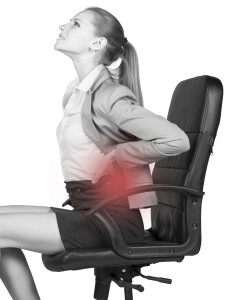Health Benefits and Risks of Sit or Standing Desks
 To Sit or Not to Sit?
To Sit or Not to Sit?
The Ergonomic Health Benefits and Risks of Sit or Standing Desks
Our bodies are designed perfectly for vigorous physical activity; to move, bend, stretch, lift and dance. But modern day living has made things a little too cozy. The statistics are alarming. Research now shows that prolonged sitting is the number one contributor to chronic disease. So what you say? Consider that 85%[1] of the workforce in America is paid to sit at a desk all day, and it becomes clear that the tide needs to turn with how we spend our working lives.
With the new and rather daunting catch-phrase of “chronic sitting is the new smoking”, what’s a desk-job employee to do?
In any workplace, a one-size-fits-all solution to chronic sitting will not succeed, as every employee and job is unique. With increased awareness of the health hazards of poor posture and sedentary jobs, we’ve seen exercise balls replace office chairs, but now it’s the actual desk that’s evolved, to get us back on our feet.
As a progressive option to the chronic sitting epidemic, let’s explore the standing desk.
The Benefits of Standing Desks
A recent study was conducted by the Center for Disease Control and Prevention among employees with sedentary jobs. It demonstrated that using standing desks reduced upper back and neck pain by 54%, and improved mood states.[2] Other benefits of standing more than sitting at work include:
Reducing the risk of developing diseases such as[3]:
- Obesity, by burning more calories
- Diabetes, by lowering blood sugar
- Cardiovascular Disease
- Cancer
And other health conditions such as:
- Poor posture
- Tight and sore muscles
- Chronic back pain
- Repetitive strains and injuries
- Headaches
- Poor circulation
But is a standing desk for everyone? Is replacing chronic sitting with chronic standing the answer for lowering chronic disease and healthcare costs?
The Risks of Standing Desks
Studies show that being sedentary in any state is what contributes to health problems, be it sitting or standing. Commenting on a recent study about the health effects of chronic standing versus sitting, Dr. Melvyn Hillsdon, associate professor of Sport and Health Sciences at the University of Exeter stated, “Any stationary posture where energy expenditure is low may be detrimental to health, be it sitting or standing. The results cast doubt on the benefits of sit-stand work stations.”[4]
In fact, depending on the current health of an employee, chronic standing all day can create its own set of problems, such as causing:
- Foot, leg and hip pain
- A compressed spine, leading to lower back pain
- An increased risk for carotid arteries, varicose veins, and deep vein thrombosis
So it comes down to a customized solution tailored to everyone’s unique needs. The bottom line is to simply move more, and be sedentary less in the workplace. What are ways to do that?
- If you’re lucky and have flexible access to a standing work station, break your day or week up between a standing desk and sitting desk. Rather than all-or-nothing, create a combination of both.
- If you have no standing desk and only have a sitting desk, opt for an exercise ball to help reduce slouching, and strengthen leg and core muscles.
- No standing desk and no exercise ball? Then simply get up more and move around. Say good-by to sitting for 12 hours a day, and incorporate walking, stretching, taking the stairs, and regular exercise into your daily life. Set a timer if you have to for every 40 minutes to get up, stretch and walk around. It’ll get your circulation moving, stretch your body and rest your eyes.
When you’re ready. Here are some next steps:
- Grab a copy of Fatal Flaws of Employee Wellness Programs. Create a wellness strategy that will actually get results. Available on Amazon here.
- Let’s skip theory and talk about your company. Set up your call here at www.speakwithalison.com

